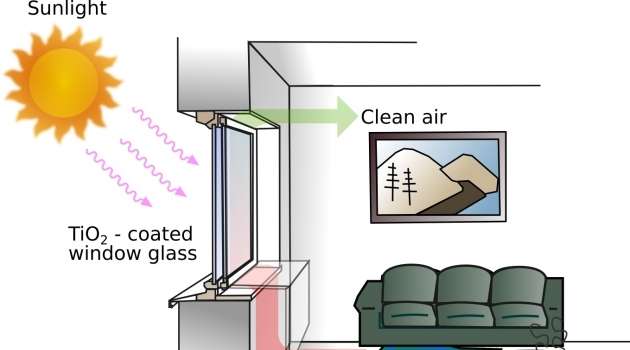Windows with nanostructured coatings can cure 'sick' buildings

Harmful organic molecules in the indoor air can cause adverse health effects—a problem known as the 'sick building syndrome'. Current air-cleaning technologies require both energy and upkeep, but a promising new solution is being developed at Uppsala University—window glass with nanostructured coating based on titanium dioxide which uses sunlight to remove organic pollutants from indoor air by passing it between the inner panes of the window.
The preparation of such coatings, tailor-made for indoor air cleaning, was studied by Bozhidar Stefanov and his dissertation shows how they can be made more effective.
Titanium dioxide is a white pigment often used in paints, toothpastes and sunscreens. In the form of nanoparticles, it obtains special properties which make it chemically very reactive. It efficiently absorbs ultraviolet light and uses this energy to destroy organic molecules at its surface in a process called photocatalysis. This has made titanium dioxide the 'white knight' of nanotechnology and the photocatalyst of choice for water and air cleaning. Recently, pavement blocks of titanium-dioxide-impregnated cement have been used to mitigate air pollution from outdoor pollution in cities. A field trial has been conducted in Malmö, Sweden.
Researchers at the Division of Solid State Physics at the Ångström Laboratory of Uppsala University are now taking the idea up a notch and harness photocatalysis for indoors air cleaning. Using an industrial process called 'magnetron sputtering', they have deposited nanostructured surface coatings of titanium dioxide onto window glass. These coatings are transparent, have a thickness a hundred times less than that of a human hair, and have been shown to be very effective for removing acetaldehyde, which is a common indoor air pollutant.
Windows comprising of such titanium-dioxide-coated glass can be used to clean air indoors, but there is one problem. Normally pollutant decomposition products bind strongly to the photocatalyst surface and block active sites, thereby leading to loss of photocatalytic activity. In his thesis Bozhidar Stefanov shows that the sputter-deposited coatings have a great advantage connected with the exposed crystalline facets of the nanoparticles comprising the coating. Just like the dices used in gambling, not all sides of the titanium dioxide nanoparticles are equal in their reactivity, and some of their crystalline facets are much more active in photocatalysis than others. Unfortunately, these active facets correspond to only about 10 percent of the nanoparticle surface, and in coatings made of randomly oriented nanoparticles it is very difficult to strike a 'lucky six' and have the reactive facets exposed at the film surface. During his project, Bozhidar Stefanov found a way to tweak the deposition of sputter deposited titanium dioxide films in order to 'cheat the dice' and have a high probability of the very reactive titanium dioxide facets at the surface.
These preferentially oriented coatings exhibit not only higher activity against air pollution, but their activity is also less dependent on external conditions such as humidity and temperature. Furthermore, he also found that if the surface of such preferentially oriented titanium dioxide coatings is made acidic by attachment of sulfate molecules they become even more resistant to deactivation. Bringing these new findings together - preferential nanocrystal orientation, sulfate modification, and controlled humidity and temperature—Bozhidar Stefanov has realized a new principle for a photocatalytic window with sustained air cleaning activity. This is an important step forward to improve indoor air.
More information: Read more about the dissertation and download the thesis: urn.kb.se/resolve?urn=urn:nbn:se:uu:diva-265056
Provided by Uppsala University




















